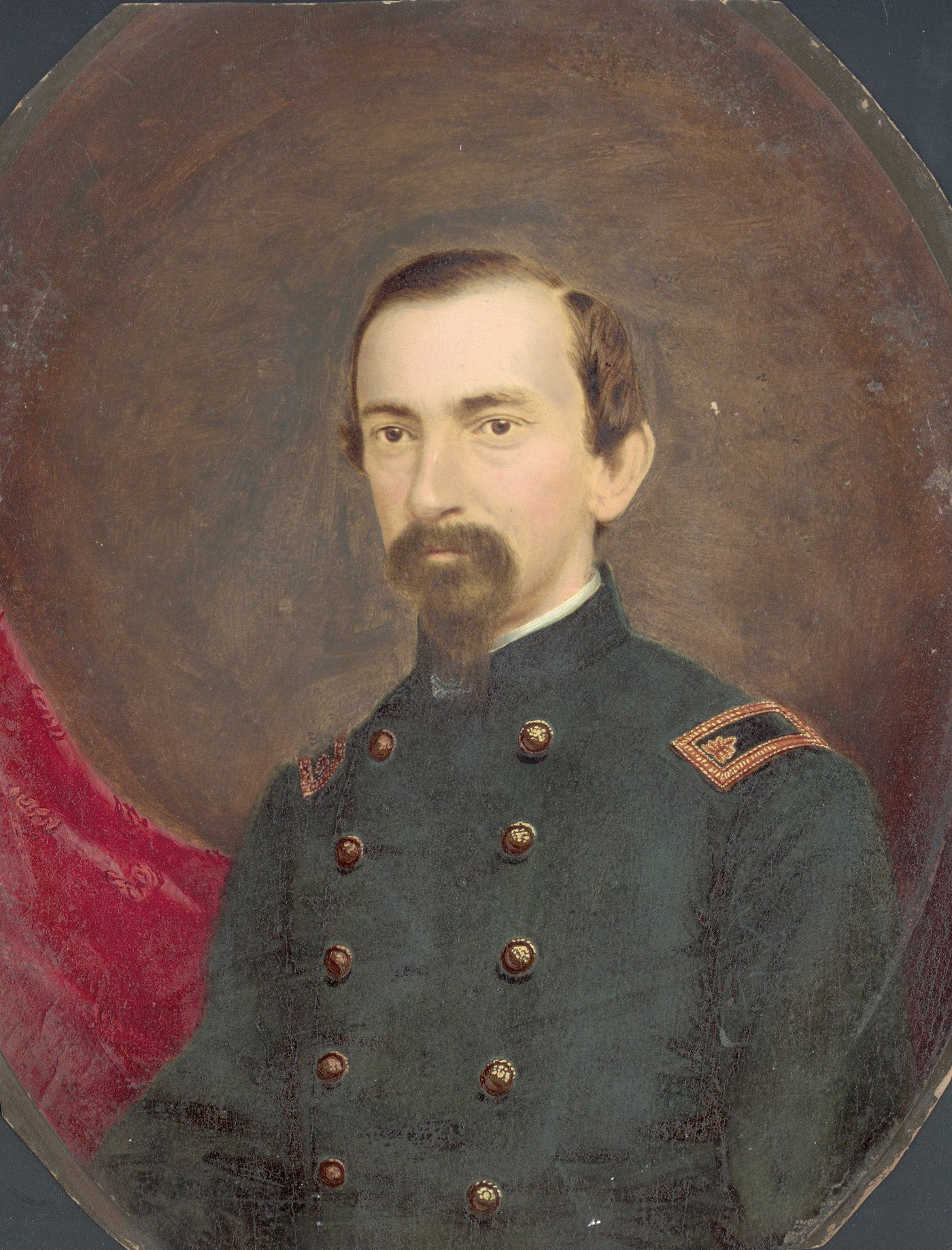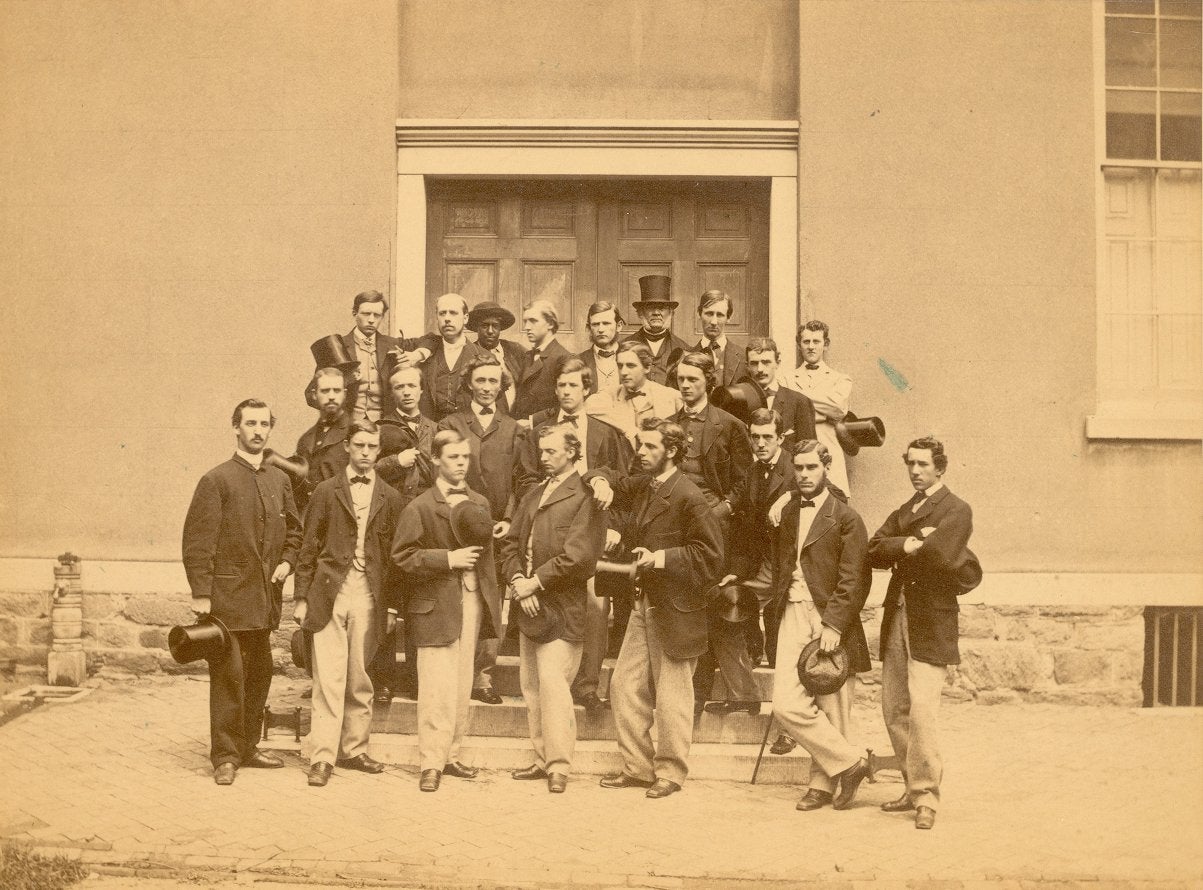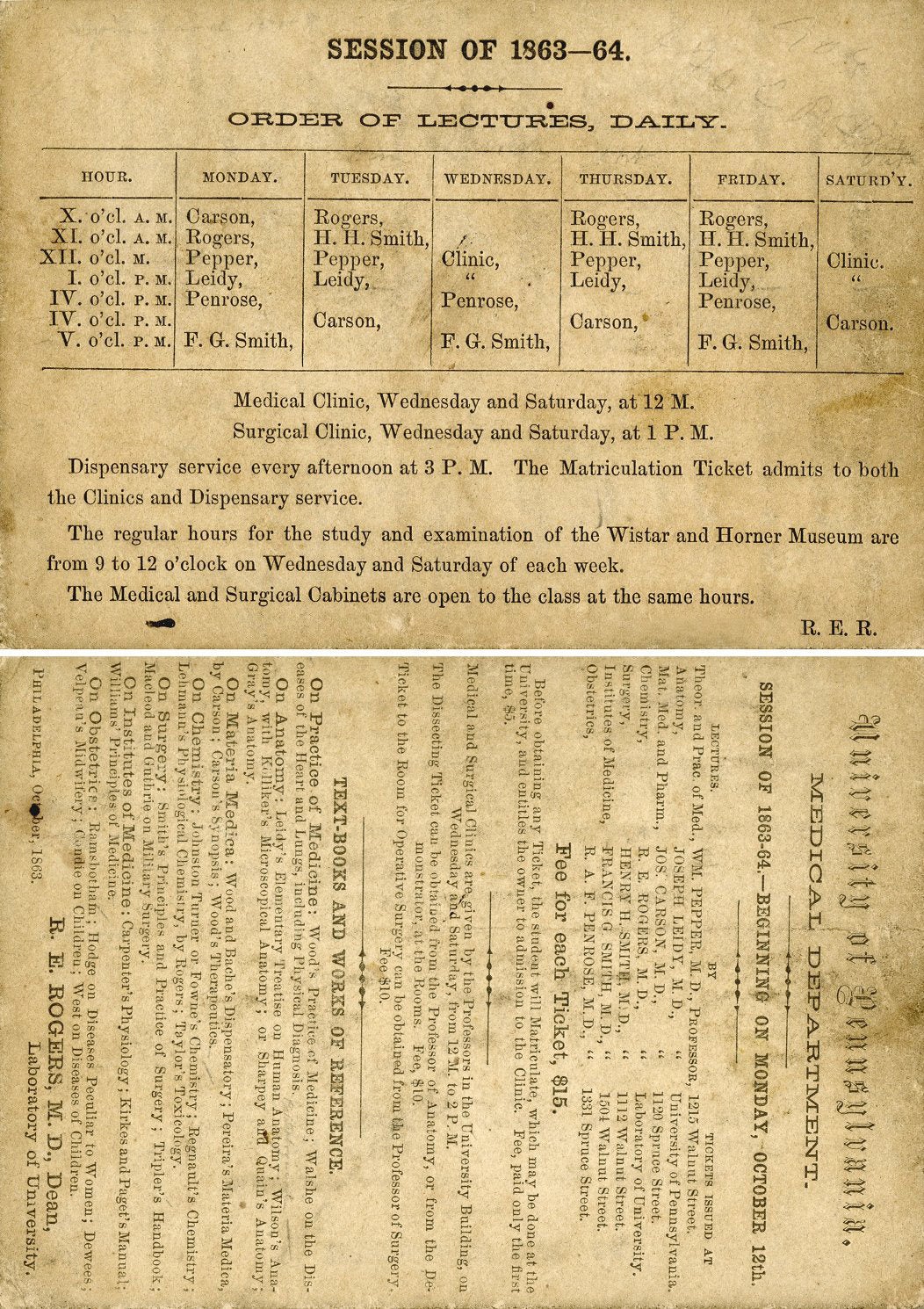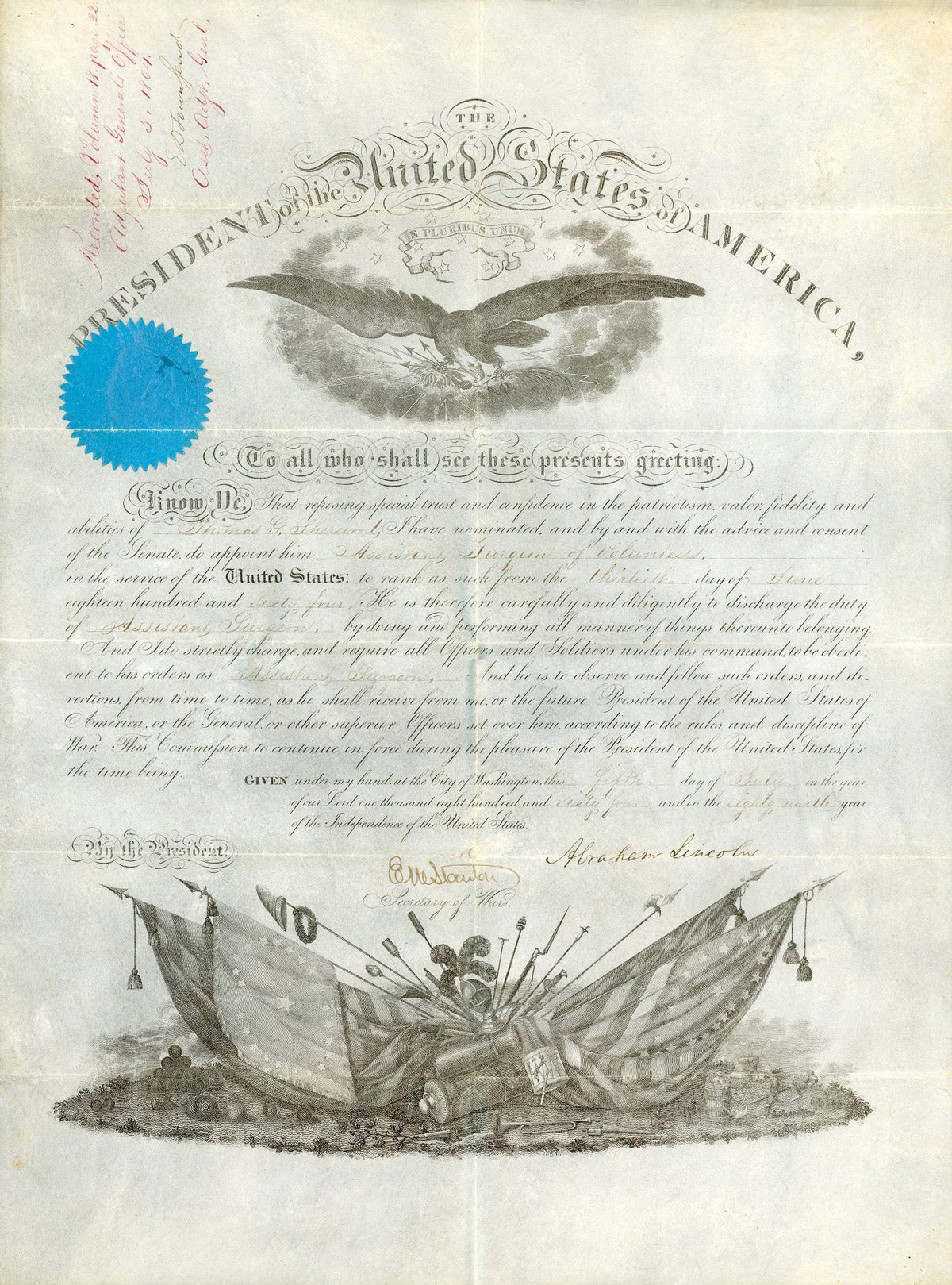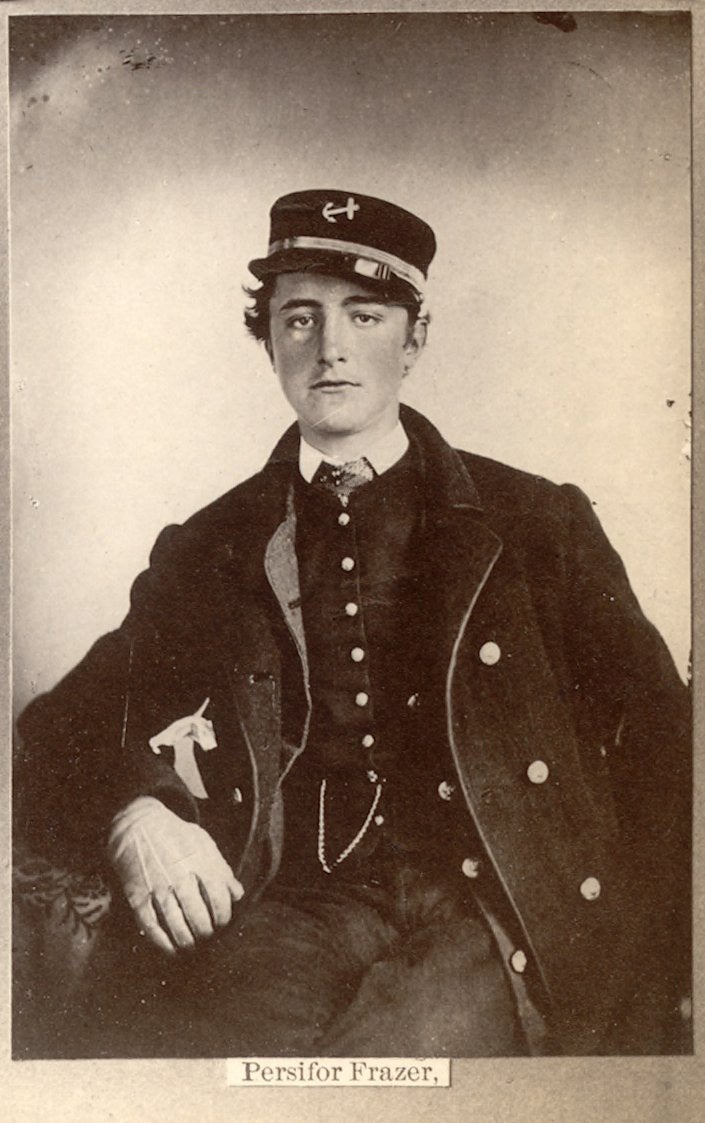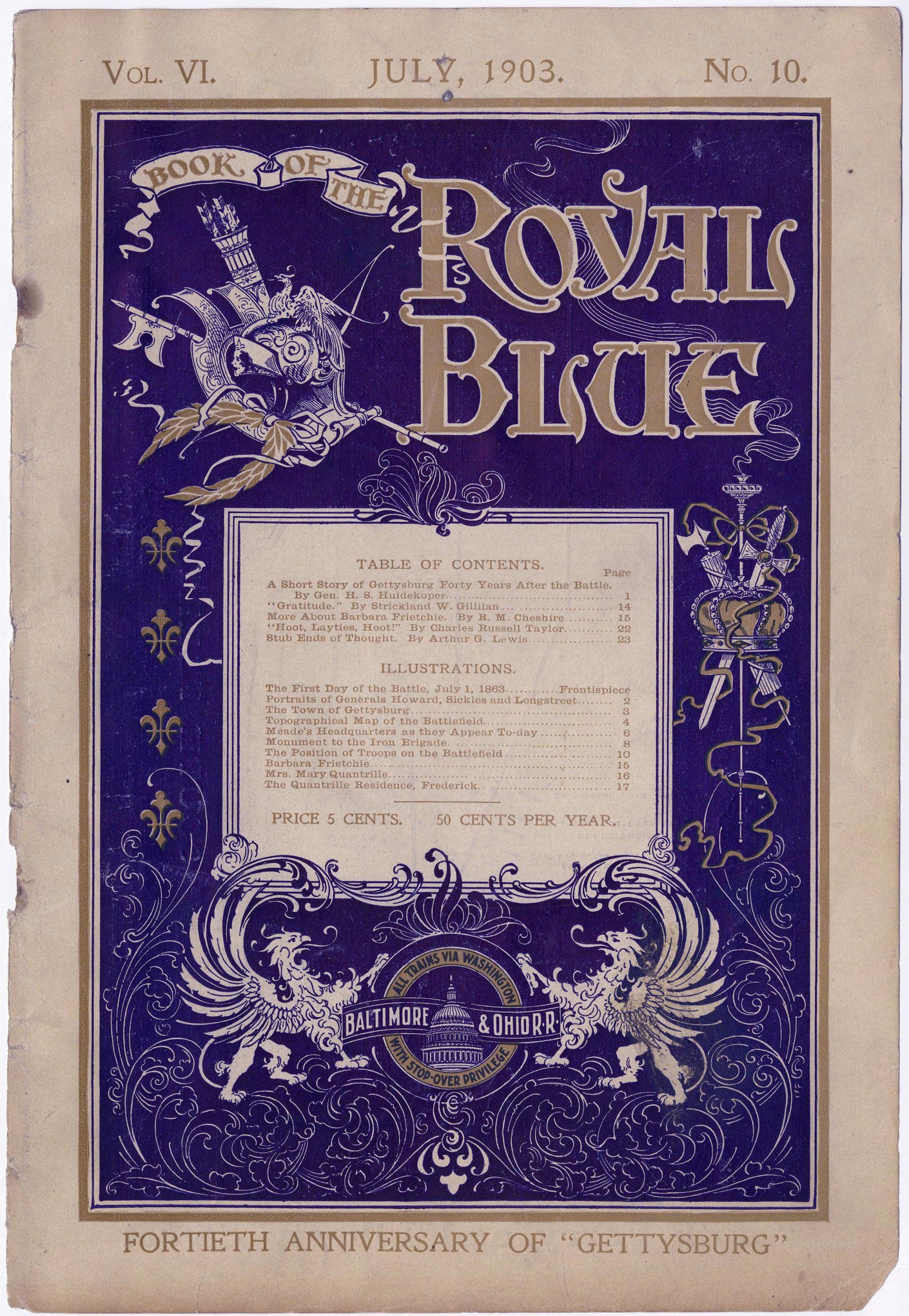Prepared by Joseph - James Ahern
November 2010
Introduction
The collections of the University Archives and Records Center document the activities of the University of Pennsylvania’s trustees, faculty, students, and alumni during the Civil War period. Included are administrative records, personal papers, and published works; these primarily reflect the operations of the University (through the Trustees and Faculty), and the experiences of the students. Other records, those of alumni and their families, relate to Philadelphia during the war. Documentation of military service is minimal, but is found within the collections.
This guide has been created to assist the researcher, regardless of interest or training, to access the Archives’ holdings related to the Civil War Period. Relevant material has been organized into the following headings: College Administration, Student Life, Medical School Administration, Philadelphia Society, Military Service, Scientific Topics, Remembrances, and Miscellaneous. Under each heading entries are arranged by archival and manuscript collections first, followed by published material. Each entry lists the collection name and classification, the box and folder number where the documents are contained, and a brief description. The guide does not contain a complete list of alumni who served in the Civil War.
Categories
College Administration
General Administration Records, UPA 3
-
Boxes 13 and 14
Contains chronologically arranged records for the University during the Civil War period – mostly student lists, grades, expenses of the University, and student petitions to the trustees related to military instruction. There are also photographs of the faculty in 1862.
College Faculty Minutes, UPB 1.1
-
Box 1, FF 10, 1856 – 1861; FF 11, 1862-1869
The Faculty Minute books record the events which relate to the students of the University – namely examinations, applications, dismissals, and disciplinary actions. The minutes also refer to students called into military service and their status, matters related to the University Cadets – including military instruction and drill, and appointment of officers. References are also made to students absent during the Battle of Gettysburg, students who died during military service, the Great Central Sanitary Fair, and the assassination of Abraham Lincoln.
Trustees Committee Minutes, UPA 1.5
-
Box 1, Minute Book of Committee on the Department of Arts (College), 1857- 1866, 1867, 1882-1889, 1894-1919
This Minute Book records meetings for the period around the Civil War, and has minimum entries in general. The business discussed relates to general University business, and in particular mentions a report on Secret Societies.
-
Box 1, Minute Book of Committee on the Academy and Charity School, 1857-1862.
The minutes reflect the basic operation of the Academy and Charity School.
-
Box 1, Minute Book of the Committee of Ways and Means, 1857-1889, 1891-1894.
The minutes relate to the financial matters of the University, and make reference to appropriations to Professor Henry Coppee for his military instruction.
Board of Trustees Minutes, UPA 1.1
-
Volume 10, 1852-1869
The minutes document the activities of the Board of Trustees in the operation of the University. While no mention of the war is made, it does document the administrative activities of the Institution.
Student Life
George Davis Budd Papers, UPT 50 B927
-
George Davis Budd (1843-1874) was a member of the Class of 1862. This small collection documents student life on campus during the early years of the war, including the Zelosophic Society. The collection contains his memoirs of 4 years at the Penn, which mentions drilling in the Light Infantry.
Frazer Family Papers, UPT 50 F848
-
Box 15, FF 15, Persifor Frazer Class of 1862
Material relates to class reunions in 1885, 1901, and 1904. Also included are images of the faculty, janitor, and class members along with an identification list.
-
Box 15, FF 16, Persifor Frazer Class of 1862, Book Proofs
Proofs for reunion book which contains images of class, including an original of Frederick Dick, Janitor.
Office of the Provost. C.C. Harrison Records, UPA 6.2H
-
Box 5, FF 27, Accounts of Expenses for Clothing, 1860-1861
A hand written account of payment for clothing while a student in the Class of 1862.
-
Box 5, FF 28, Student Papers and reports, 1858-1862
Papers written by Harrison while at the University, and reports of his class standing.
Dean of Student Affairs Disciplinary Records, 1829-1865, UPE 5.45
-
Box 1, Folder 6
The letters are mostly from students and their families to the dean acknowledging misbehavior by the student and asking for re-admittance to the University.
Zelosophic Society, UPS 44.2
-
Box 3, FF 1, Minutes, February 1854 – June 1864
The minutes record the debates and activities of the Society. Pre-Civil War debate topics included “Is the fugitive slave law in accordance with the Constitution?” in 1854 and “Is it right or wrong to hang ‘Old Brown'” in 1859. In 1860 other debates focused on a standing army, political parties, who should elect the president. Overall, the minutes review the meetings of the Society, and while they do debate topics of relevance the full debate is not presented, nor are comments made regarding events during the war.
-
Box 4, FF 10 & 11, Roll books
Provides a list of names of members with some addresses.
-
Box 4, FF 19, Committee Reports and Resolutions, 1851-1872
Details basic upkeep material for the Society.
-
Box 5, FF 8, General activities, programs, 1862-1865
Programs of activities.
-
Box 6, FF 21 – 27, The Zelosophic Review, 1861 – 1865
Handwritten “magazine” of the society. As with other aspects of the society some topics touch on the war, others are more broad. Also includes reviews of the meetings, and at times hand drawn illustrations.
Alumni Register, UPM 8115
-
Vol. 17, No. 8, 1915
“The Commencement of 1863 and the University in the Civil War” by James W. Ashton, pp. 593-600.
Alumnus recounts his take on the commencement of 1863 and the events of Gettysburg on Philadelphia and the College.“Some Recollections of College Days at the University of Pennsylvania During the American Civil War, 1861-1865” by William Brook Rawle, pp. 600-611.
Author provides comments on, as a member of the Class of ’63, his experience during the war on campus and in the military. Mentions those from various classes who served, and at the end discusses the lack of a memorial to former alumni who served.
General Magazine, UPM 8115
-
Vol. 31, No. 3, 1929
“The Class of ’62” by Charles C. Harrison, pp. 341-344
Harrison’s recollection of the Class of 1862, along with a page of images of members of the class.“Four Years at the University of Pennsylvania: A History of the Class of 1862, College” by George Davis Budd, pp. 345-396.
Publication of George Davis Budd’s memoir recounting his time as a student of the University, printed posthumously and edited most likely by Charles C. Harrison.
Medical School Administration
Medical Leadership at the University of Pennsylvania Records, 1844 -1904, UPP 80
-
Box 1, FF 1
Pamphlet published in 1904 giving an overview history of Medical School, with references to the Civil War.
Faculty Minutes, UPC 2.1
-
Box 1A, Volume 5, 1853-1873
The Faculty Minutes discuss matters related courses, when instruction should begin, financial matters, etc. While comments related to the Civil War are few, it does document the impact of specific events to the Medical school. For instance, an 1859 entry states that a true account of students who left should be determined to dispel rumors. An 1862 letter from Surgeon General Hammond is included asking that a professor of hygiene and military surgery be added. In 1863 the matter of graduating students early for service into the military arises.
Financial Records, UPC 2.5
-
Box 3, #2 Ledger, 1850-1876
The ledger gives a running account of the finances of the Medical School before, during, and after the Civil War. Shows diploma fees, expenses for upkeep and services (including advertising) incurred.
Student Records, UPC 2.7
-
The records for the Civil War period provide names of students, home states, and local addresses / boarding houses.
Medical Affairs, UPL 1010.915
-
Vol. 2, Nos. 1 and 2, 1961
Special issue of Medical School publication that featured stories on the Medical School alumni and the roles they played during the Civil War.
General Magazine, UPM 8115
-
Vol. 48, No. 4, 1946
“The Medical Tradition at Pennsylvania,” by William S. Middletown, pp. 224-236. Makes mention of medical school and Civil War impact.
Philadelphia Society
Cornelius Nolen Weygandt Diaries, UPT 50 W547
-
Cornelius Nolen Weygandt (1832-1907) was a clerk and later cashier with the Western National Bank in Philadelphia. His diaries for the period of the Civil War provide commentary on the secession crisis, Abraham Lincoln in Philadelphia, and the firing on Fort Sumter. Over the next four years his commentary reflects more his daily activities, health, weather, and events at the bank. He does remark on the Gettysburg Campaign, and the events at the close of the war. Interestingly, he has more commentary on events in the Western Theater of 1861 than in the Eastern Theater. The diaries are a good source for social life in Philadelphia during the war (including the opera season starting 1863), and the banking world. Weygandt drilled with an artillery company during the early years, but seems not to have continued.
-
Box 1, FF 23, Diary, 1861
Diary reflects mostly his day to day activities. Comments on Abraham Lincoln being in Philadelphia and the events at Independence Hall for Washington’s Birthday in February, Fort Sumter in April, and drilling with his artillery company. Gives his hopes for a change on New Year’s Eve. Also comments on changes to banking.
-
Box 1, FF 24, Diary, 1862 January 1 – September 1
Comments on events – mostly in the west. Continues to comment on work and home. Drilling with artillery company.
-
Box 1, FF 25, Diary, 1863 January 1 – May 9
Refers to the opera season at the Academy of Music, his personal life, and reading. No discussion of events regarding war.
-
Box 1, FF 26, Diary, 1863
Small pocket diary. Seems to have switched to this book from the above possibility on account of size. Makes note of Gettysburg Campaign – but not much in the way of commentary. Reflects on books read, work at the bank, and theater attendance.
-
Box 1, FF 27, Diary, 1864
Very little comment on the war. The majority of entries relate to his personal life principally his courting of Lucy Elmaker Thomas and his activities at the bank.
-
Box 1, FF 30, Diary, 1865
Comments on the surrender of Lee, Lincoln’s assassination, and funeral.
Alfred Fitler Moore Family Papers, UPT 50 M821
-
Box 3, FF 5, William F. Moore Diary, 1864-1865
Fragment of a diary kept by William F. Moore, who was involved in the family wire business, that has mostly work and social commentary.
Clark and Madeira Family Papers, UPT 50 C592
-
Box 1, FF 16 Edward White Clark Diary, 1863 January 1 – September 11
Personal diary kept by Clark who was senior partner of the banking firm E. W. Clark and Company. Entries primarily comments on social activities and weather. Clark does comment on Gettysburg, and a friend wounded in the battle. Also notes visit to U.S. Colored Regiment in West Philadelphia.
Robert Dechert Family Papers, UPT 50 D293
-
Box 3, FF 15, Dechert, Henry Martyn Minute Book – West Philadelphia Guard, 1861-1862
Minute book for the formation of a militia company based in West Philadelphia for the defense of the city during the “present crisis” for which Henry Martyn Dechert was a member. The minute book details rules for the organization of the unit, uniform, officers, and by-laws. Many notable residents of the area are mentioned – including Anthony Drexel.
Military Service
Thomas Humphries Sherwood Collection, UPT 50 S554
-
The collection documents Sherwood’s promotion as a surgeon in the Union Army. There are two pieces of correspondence to his wife (one letter, one telegram), with the letter expressing his views on service and events in the 3rd PA Cavalry; and the telegram informing his wife of a promotion and to come to Washington. Images of Sherwood, as well as certificates and memorabilia are included.
Robert Dechert Family Papers, UPT 50 D293
-
Box 4, FF 2, Dechert, Robert Porter Civil War Diary, 1865 January 17 - April 17
The cover of the diary notes “Asst Adj Gen Dept Hd Qts Left-Wing Army of Georgia.” The diary recounts the movements of the Army from Savannah into North Carolina.
McClellan Family Papers, UPT 50 McC623
-
Box 1, FF 5, Arthur McClellan Correspondence
Includes an 1863 Headquarters Department of Washington pass for “Capt McClellan & Dr. Crehore,” notes for corrections to reports, 1863, and miscellaneous calculations made on “Head-Quarters, Army of the Potomac, 1862” letterhead.
Despite the prominence of McClellan – the collection contains no letters from George B. McClellan, or in relation to the Civil War. The one piece of correspondence to George B. McClellan is from his nephew dated 1875 and relates to family matters.
Richards Family Collection, UPT 50 R514.1
-
Box 1, FF 5, Miscellaneous correspondence
Copy of letter dated 19 August 1863 from M. C. Meigs to L. W. Leeds at Calvert and Vaux Architects in NY authorizing them to draw up plans for the Western Hospital. Richards copied the letter.
James Tyson Family Papers, UPT 50 T994
-
James Tyson, an 1863 graduate from the University of Pennsylvania Medical School, worked as a acting assistant surgeon at the Army General Hospital at Broad and Cherry Streets during the Civil War. During the Gettysburg Campaign he was temporarily assigned to the Army hospitals in Harrisburg, PA. Being a Quaker – Tyson served as a contract private physician to the Army, and never held a military position.
-
Box 1, FF 2 Henry Tyson Correspondence
Captain Henry A. Lantz to Henry Tyson, June 2, 1864 – Lantz of Co. E 50th Regiment Pennsylvania Volunteer Infantry writes from “Battle Field on Pamunky River” about the engagement on May 12 at Spotsylvania Court House, and the capture of two members of the Regiment.
Jacob Tyson to Henry Tyson, December 2, 1864 – After personal material describing his trip home to Warrensburg, MO, describes the effects of Confederate Major General Sterling Price’s raid into Missouri, in terms of the sense of security residents feel, and material taken during the raid.
-
Box 1, FF 7 – 9, 15-19 James Tyson Correspondence
1861-1865, contains correspondence from James Tyson to his father Henry, step-sister Amanda Caswell, and his future wife Fannie Bosdevex many written from the U.S. Army General Hospital at Broad and Cherry Streets in Philadelphia where James served first as an acting medical cadet and later as an acting assistant surgeon. Some of the letters written to Fannie in 1863 are during James time in Harrisburg. Among the 1865 correspondence to Fannie is a broadside for entertainment at the Broad Street General Hospital on January 7, 1863.The Civil War materials sent to Fannie include Confederate currency, state seals, and five cent sutler paper scrip notes for the 32nd Regiment Pennsylvania Volunteer Infantry.
-
Box 1, FF 23 James Tyson Diary, 1862
James’ diary recounts his views of events that took place around him during the year – including conclusion of his medical studies, duties at the General Hospital, and personal matters. An entry in September does mention briefly the Battle of Antietam in relation to the medical staff at the hospital.
-
Box 2, FF1 Miscellaneous Correspondence
Contains an 1865 order to Tyson to report to Camp Cadwalader to examine recruits, and his 1864 contract as an acting assistant surgeon.
Office of Alumni Records Biographical Records, UPF 1.9 AR
-
The collection consists of biographical files for deceased alumni and faculty. During the late Nineteenth Century questionnaires were sent out that inquired about military service. Those returned by Civil War veterans have varying degrees of information.
Alumni Register, UPM 8115
-
Vol. 15, No. 1, 1912 through to 1914
“University of Pennsylvania Men Who Served in the Civil War” by Jordan first appears, pp 20.
-
Vol. 18, No 7, 1916
“The University’s Men in the Civil War” by Major John C. White, pp 631-636.
White, a Penn alumnus, responds to Rawle’s article and discusses various graduates who served in the war. -
Vol. 18, No. 8, 1916
“William Brooke Rawle” by Francis Rawle, pp. 691-695.
Biographical memoir of Rawle, recounts his Civil War service.
General Magazine, UPM 8115
-
Vol. 45, No. 1, 1942
“A Hospital at Gettysburg” by William Fisher Norris, pp 34 – 41.
Small group of letters from William Fisher Norris (1839-1901) to his parents during his time at Gettysburg (July 7 – 27, 1863) as a surgeon in charge of 3rd Division, 1st Corps hospital following the battle. While the location of the original letters is unclear, the Historical Society of Pennsylvania does have a collection of Norris Family Papers.
-
Vol. 60, No. 1, 1957
“Three Letters from the Front, 1864-1865,” by Henry C. Parry, pp. 7 – 16.
Collection of letters from Parry – surgeon in 2nd US Cavalry in Sheridan’s Army of the Shenandoah – to his father.
Scientific Topics
Fairman Rogers Papers, UPT 50 R725
-
Box 1, FF 7, Rogers Diary, 1862 April 9 - 1862 June 29
Journal of the Potomac River Survey in 1862 as requested by the Navy Department.
Frazer Family Papers, UPT 50 F848
-
Box 3, FF 5, John Fries Frazer Correspondence with Alexander Dallas Bache, 1862-1867
Correspondence to Frazer from Bache for the most part is personal. Some materials from 1863 relate to the creation of the National Academy of Science, and to Frazer’s service on a NAS committee to examine the hydrometer of Joseph Saxton.
Remembrances
Frazer Family Papers, UPT 50 F848
-
Box 15, FF 30, Persifor Frazer First City Troop Civil Action
Documents, maps and correspondence relating to the First City Troop at Gettysburg, includes Pamphlets “Gregg’s Cavalry Fight at Gettysburg” 1884, and The Baltimore and Ohio Railroad’s BOOK OF THE ROYAL BLUE, vol. 6, no. 10 July 1904 Fortieth Anniversary of “Gettysburg.”
Richards Family Collection, UPT 50 R514.1
-
Box 1, FF 13, Correspondence and Notes relating to Civil War Monument in chapel
Correspondence, invoices and description of monument erected in the University Chapel to honor alumni who died in the Civil War, 1877-1879.
Alumni Register, UPM 8115
-
Vol. 15, No. 5, 1913
“The Battle Abbey of the Confederacy”, pp. 227-229.
Discussion of architecture designed by Penn grads – which is now the home to the Virginia Historical Society.
-
Vol. 17, No. 8, 1915
“The Civil War Reunion” by editor, pp. 589-591.
Mentions upcoming reunion of alumni who served as the 50th anniversary of the war’s end approached – gives 2-3 small accounts of alumni as well as the artillery brigade of the campus.
Miscellaneous
Centennial Collection, 1876, UPG 500
-
Box 1, FF 1, "Civil War Songs"
Contains 12 broadsides of songs and poems from the Civil War Period.
-
Box 1, FF 2, "Gettysburg Star Extra, 1865"
Copy of the extra page from the Gettysburg newspaper regarding the assassination of Abraham Lincoln. Written in pencil is “April 15th, 1865.”
General Magazine, UPM 8115
-
"John Brown’s Raid," by Joseph G. Rosengarten, pp. 22-41.
Recounts Rosengarten’s personal experience encountering the effects of John Brow’s Raid in Harpers Ferry, VA.
-
Vol. 55, No. 3, 1953
“The Death of a President April 15, 1865,” by Francis A. Haugh, pp. 114-116.
Brief article on Abraham Lincoln’s assassination.

